|
Canon EF 40mm f/2.8 STM - Full Format Review / Test Report - Analysis |
|
Lens Reviews -
Canon EOS (Full Format)
|
|
Page 2 of 3

Distortion
The Canon pancake lens produces only a slight amount of barrel distortion (0.6%) which is basically negligible.

Vignetting
Typical for most lenses used on full format cameras, the EF 40mm f/2.8 STM shows some light falloff at large aperture settings. A vignetting of 1.7EV (f-stops) will be very noticeable at f/2.8. However, the issue is substantially reduced at f/4 and not really a problem anymore from f/5.6 onward.

MTF (resolution)
Pancake lenses tend to be easy beings - due to their comparatively slow speed their design is not overly complicated. Consequently we can report positive results from the MTF lab. The center resolution is already excellent if not outstanding at f/2.8 and even the borders & corners are easily very good. Stopping down to f/4 or f/5.6 improves the performance a little bit but it is primary about increasing the depth-of-field here. The performance decreases slightly at f/11 and the results are still usable at f/16.
There is a bit of field curvature but not to a worryingly degree.
The tested sample had a good centering quality.
Please note that the MTF results are not directly comparable across the different systems!
Below is a simplified summary of the formal findings. The chart shows line widths per picture height (LW/PH) which can be taken as a measure for sharpness.
If you want to know more about the MTF50 figures you may check out the corresponding Imatest Explanations
Chromatic Aberrations (CAs)
Lateral CAs (color shadows at the image borders) stay at or below an average pixel width of 0.5px at the image borders. This is basically negligible.

Bokeh
You may debate whether the bokeh (quality of the out-of-focus blur) plays a major role in a 40mm f/2.8 lens. After all you have to choose a rather short focus distance in order to achieve a decently shallow depth-of-field. However, Canon outlines this aspect as a strength of the lens so let's have a look at it.
The out-of-focus highlight rendition is pretty good - at least near the center. The shape of the highlight disc is pretty circular here and the inner zone is pretty smooth. However, there is a rather pronounced outlining effect at f/2.8. The outlining is gone once you stop down a bit.
 The situation changes a bit when moving to the border region. The highlight shape deteriorates to a "cat's eye" here. Now, this is nothing unusual but it's still not optimal.
The situation changes a bit when moving to the border region. The highlight shape deteriorates to a "cat's eye" here. Now, this is nothing unusual but it's still not optimal.
 The quality of the general blur in the focus transition zone is decent. The foreground blur is a bit busy whereas the more critical background blur is smoother but still not perfect.
The quality of the general blur in the focus transition zone is decent. The foreground blur is a bit busy whereas the more critical background blur is smoother but still not perfect.

Bokeh Fringing / Longitudinal Chromatic Aberrations (LoCA)
The so-called bokeh fringing refers to colored halos in the focus transition zone. Hard contrasts can have a purple color tint in the foreground changing to greenish beyond the focus point. The EF 40mm f/2.8 STM shows a very slight bokeh fringing at f/2.8 but it's basically gone by f/4 already.
If you scroll through the sample crops below you may notice another effect though - there is a bit of a focus shift when stopping down (residual spherical aberration). The focus hot spot moves towards the background here.
|
Move the mouse cursor over the f-stop marks below to observe the respective LoCAs
|
| f/2.8 |
f/4 |
f/5.6 |
|

|
|